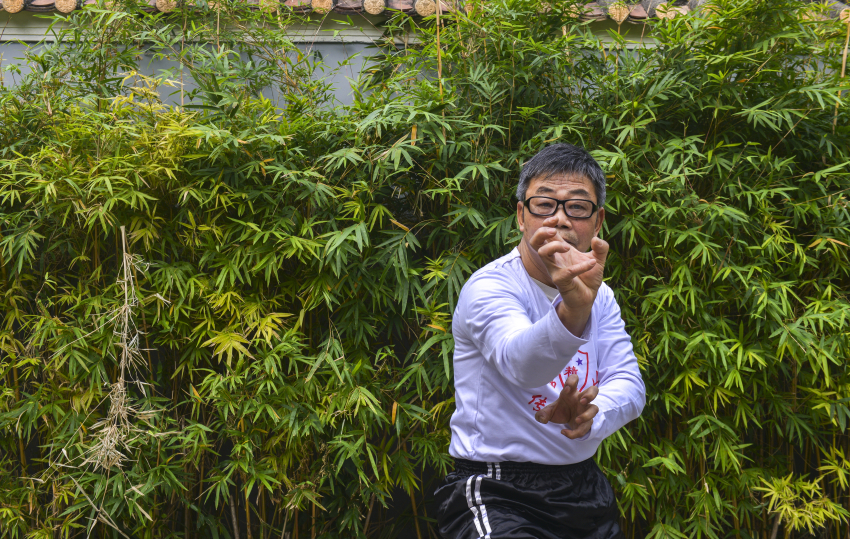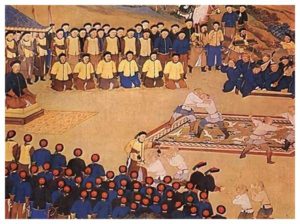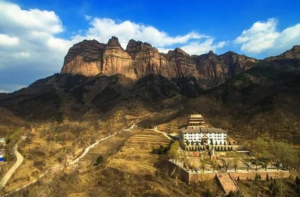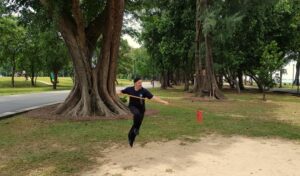Chou Deji (仇德基 Chow Tak Gei) is an inheritor of Futsan Pak Mei, having learnt from both his father Chou Taisheng (仇太生) and martial uncle Liu Shaoliang (刘少良) whom where taught by Chou Deiji’s grandfather, Chou Wu (仇乌). Liu Shaoliang had also studied Choy Li Fut in addition to Pak Mei. Chou Wu (仇乌) studied under Xia Hanxiong (夏汉雄), who was one of the early disciples of Pak Mei Pai founder, M Zhang Lichun (张礼泉 Cheung Lai Chuen ).
Today, it is recognized that Chou Taisheng was the earliest practitioner of Pak Mei to teach in Futsan, can you explain the situation there at the time ?
Chou: After liberation, Father taught Pak Mei boxing as a means of supporting the family. In those days usually fees were charged monthly, I cannot recall the exact amount. There were very few students/disciples until Master Liu (Liu Shaoliang) came, thereafter the Pak Mei style was more widely practiced.
What is the difference between your father’s and Liu Shaoliang’s Pak Mei ?
Chou: Master Liu empasized fast and dynamic hand techniques whilst my father stressed the importance of power and weapons practice. Father often would mention that Master Liu’s skills were better and that is why he wanted me to also become a disciple of Master Liu.
You must have accepted quite a few students/disciples of Pak Mei right ?
Chou: I took students on from a very young age, in addition to the Futsan Jingwu association and the Futsan Martial arts association where I was the Coach for over 3 years, but the students usually take it for granted. In fact, there are very few in Futsan who really are interested in Pak Mei. However, there are many foreigners who are obsessed with Pak Mei, and I came across who had a lot of passion for studying our boxing. Some from nearby countries, like Malaysia and Singapore came to study our Futsan style, having studied Pak Mei previously. There was one specific foreign student who studied one routine (set) with me, a few years later he made the special trip of returning all the way from Argentina to ask me to teach him another routine. When he first came he could not speak chinese, but second time round he learnt to say “”Shifu'” to me and even showed pictures highlighting my father as “Zhe shi Shi Gong”” (This is grand master).
So how is the popularity and development of Pak Mei in Futsan today ?
Chou: In comparison to other boxing styles, today in Futsan there not many who study Pak Mei. It is likely that amongst all the counties in the city there are around 100 or so students/practitioners. In terms of really having a martial arts school for Pak Mei, only Liu Shaoliang son Liu Weiji opened a “Liu Shaoliang Memorial Hall”.
Why are there so few practitioners ?
Chou: This is actually a problem related to society and the pressures of other interests or objectives in modern life.
So are you dissappointed with the state of Pak Mei then ?
Chou: There can’t really be dissappointments since history always experiences it’s ups and downs. It would be a hope for me that in Futsan some sort of Pak Mei boxing centre could be establshed and that many more people do not think of it as just a hobby or casual activity since such a mindset is likely to change. Rather, I hope that they could embrace it as a form of life.
In terms of the content, Chou Deji highlighted that the most representative boxing are the Sup Ji Kuen, Gao Bo Toi, Sup Bat Mo Kiu and Fu Bo. The Sup Ji Kuen is seen as the most basic, yet it should not be seen as easy since its practice is very challenging. Gao Bo Toi is the most representative of the Pak Mei style, it has 9 basic hand methods, and each of the hand methods have nine variations which total over 81 combinations. Other than this, there is the Fu Bo (Tiger Step) which is considered highly powerful and specialized.




